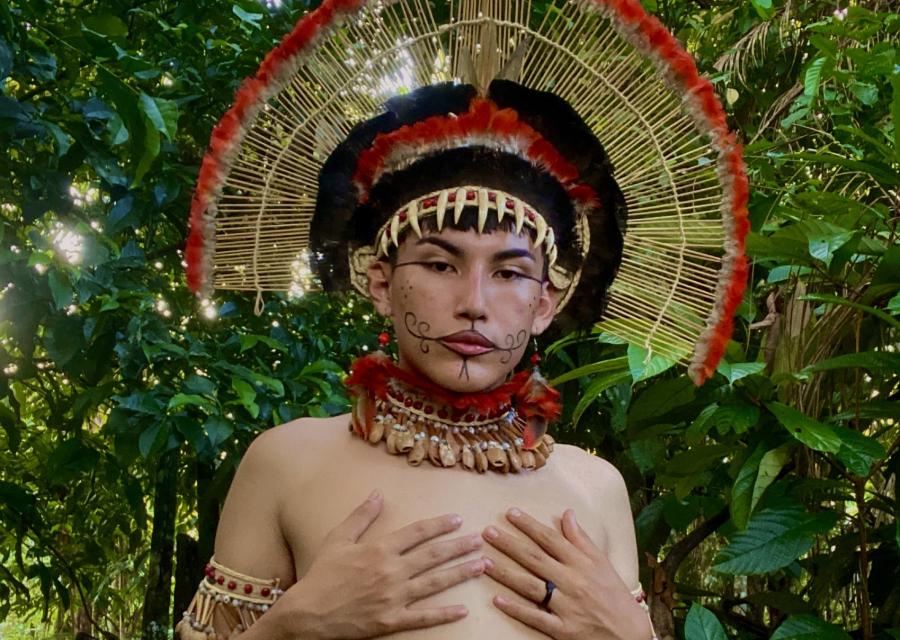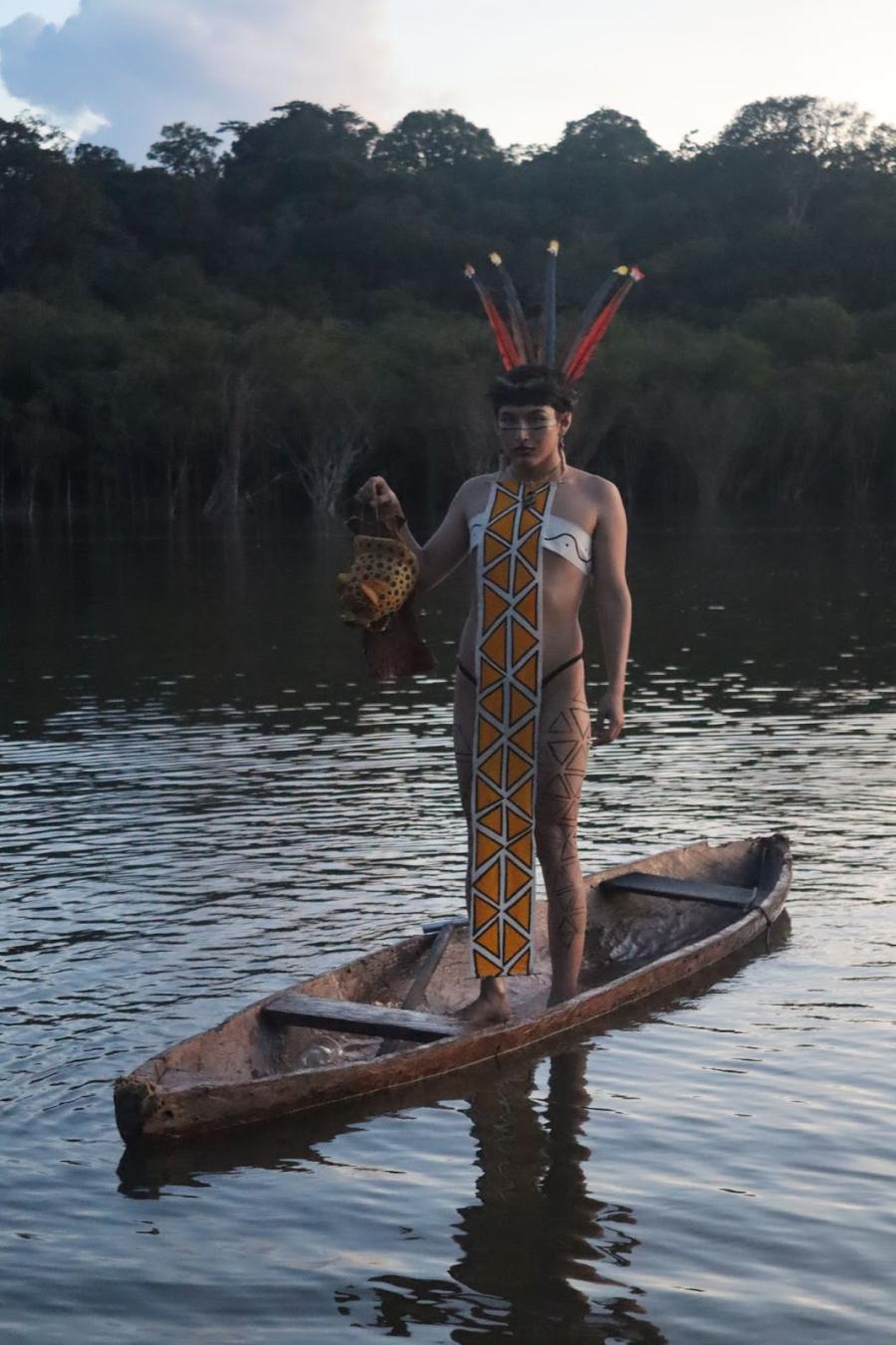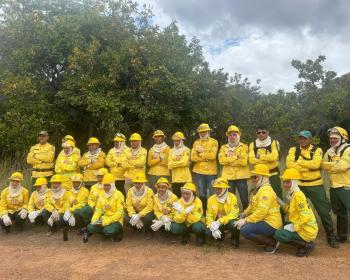For long-term survival, human populations must maintain a balance between their rate of harvest and the yield of an area. There is evidence that indigenous communities have evolved cultural mechanisms which, in effect, manage extraction activities to reduce the probability of irrevocable destruction to important but fragile resources. The Tukano of the Uaupés basin in the Northwest Amazon reserve the forested river margin for fish and fishing. In addition, fishing may be restricted to as little as 38% of the total river margin available. The result is a management system which allows for, yet distinguishes, human use areas and animal refuge areas.
Indigenous populations such as the Tukano Indians of the Upper Rio Negro have managed the blackwater ecosystem for generations by reserving the natural vegetation of the riparian forest for fisheries maintenance rather than deforesting the margin for agriculture. Tukano resource use is an example of rational ecosystem management with long-term economic benefits, because fish production in the standing flooded forest is of greater potential than is agricultural use of the deforested blackwater floodplain.
The Tukano number approximately 10,000, divided into named patrilineages whose hamlets are situated along the Uaupés river and its two main tributary streams, the Papuri and Tiquié. The area lies at the Brazil-Colombia border, with the Uaupés and Papurí delineating the border at one degree of latitude above the equator. The Arapaço, who are discussed below, are one exogamous pabrilineage in the Tukano aggregate.
As with many riverine native Amazonian populations, the Tukano subsist largely on root crop cultivation and fishing. Manioc is the principal carbohydrate source and primary crop, comprising about 85 percent of garden yields. Apart from few small mammals and birds, fish provides almost all animal protein in the Tukano diet.
The Uaupés as a Fragile Ecosystem
The basin of the Uaupés and its tributary streams in the lowlands of Colombia is an area whose tertiary rock base releases little dissolved inorganic material to enrich the waters. As such, the waters of the Uaupés are nutrient-deficient; likened by some scientists to distilled water. As part of the larger Rio Negro complex, into which these waters flow, the Uaupés is designated a blackwater river, referring to the dark pigment of dissolved humic compounds derived from decaying vegetation. Blackwaters such as the Uaupés are not only lacking in the important nutrients which form the bases of food chains, but they are additionally deleterious to fish populations due to high levels of undesirable acids and metals. Since blackwater rivers do not contain the levels of nutrients necessary for in situ production of large amounts of primary phytoplankton, these rivers are of limited primary productivity and have been referred to as "rivers of hunger".
With the in situ nutrient supply now, fish are dependent upon plant and animal life which fall into the water from the adjacent forest, or are engulfed by the waters during the rising floods. The dynamics of this system are especially dramatic during the two annual high-water seasons. The rivers swell and overflow their banks, merging the aquatic and terrestrial realms. Fish gorge themselves - spreading through the flooded forest and feeding on the abundance of forest foods only then available.
Tukano Forest and Fish Management
Over millennia, indigenous populations have observed and managed the floodplain, structuring many of their economic institutions around the physical and limnochemical limitations of infertile blackwaters. As fishermen dependent upon these river systems, the Tukano are aware of the relationship between their environment and the life cycles of fish, particularly the role played by the adjacent forest in providing nutrient sources that maintain vital fisheries. Strong Tukano proscriptions prohibit deforestation or cultivation of the river margin which is viewed as part of the aquatic system.
Tukanoan Ideology
From the Tukano point of view, the river margin belongs to the fish, not to man. Therefore, men may not deforest the river edge and deprive fish of their feeding grounds. Deforesting the floodplain would result in drastic reductions in fish populations. Since the soils are as poor in nutrients at the river edge as they are inland, no advantage would be derived from removing the riparian forest for farming. Furthermore, more protein can be derived from fishing in the flooded forests than utilizing such areas for agriculture. It is during the highwater seasons, when fish are dispersed into river margins, that there are the greatest number of fishing taboos. These taboos are crucial to traditional resource management. Tukanoan beliefs regarding human-animal interactions are marked by two principles that are key to Tukanoan thought: boundedness and reciprocity.
Boundedness. The Tukano conceive of the world as "families in place." (There are, of course, families which are out of place, but this simply reinforces the model of things as they should be and may not always be.) The human world consists of localized sibling units. The animal world, likewise, consists of lineages of animals considered to be "brothers," each of whom has a designated "sitting and breathing place" (duhinia). For humans as well as animals the proper sitting and breathing place is where the ancestors "sat," for their souls are recycled in alternate generations. Continuity in space is a critical dimension of Tukano lineal regeneration and is considered equally important to animal groups, such as fish. The absolute dominion of each group in its "sitting place" must be respected.
Reciprocity. Such bounded groups may trade or transact across the social and spatial boundaries which separate and define them. Such exchanges are carefully monitored, with numerous words used to describe types of debts.
No transaction is settled until its payments are compensated. This is the case, for example, in the trading of daughters as wives across exogamous groups; in the repayment of ceremonial gifts, which are expected to match in value the original gift; in disputes or in war, where a retaliatory act is necessary to correct an initial transgression. The same principle applies in each case: a loss on one side must be compensated by a comparable loss on the other. Balance must prevail.
Like the Tukano system of patriclans, each first or animal patriclan is headed by a "senior," and "oldest brother," or "first ancestor." It is this "pater familias" who, in Tukanoan belief, will go to extreme means to protect his group. He keeps close watch over his descendants and will retaliate if one of these is taken. He will take one human infant for every one of his offspring taken.
Such animal guardians are dangerous, indeed, but they are not ubiquitous. Examining the locations of such guardian spirits and the associated taboos reveals patterns suggesting that their impact on the maintenance of fish populations is significant.
The Effective Consequences of the Proscriptions
One Arapaço village was studied in detail to determine the extent of fishing prohibitions and the relationship of prohibited areas to fish population conservation. The Arapaço, a Tukanoan-speaking tribe, are located along the lower Uaupés River. My 1979 census shows an Arapaço population of 202, based in five contiguous settlements ranging from 11 to 83 inhabitants each. Each of the five settlements is thought to have fishing dominion over a defined length of river. Within this area, however, 26 guardian spirits are thought to restrict access to fishing locations.
What are the effective consequences of these proscriptions? To what extent do these proscriptions reduce the effective area of exploitation? And, is there a correlation between the proscribed locations and ecologically meaningful features?
The village of Parana Jucá is the furthest upstream of the Arapaço villages. Its population of 38 has complete fishing dominion over 8.8 kms on the Uaupes River and 29 of its tributary streams, totalling 164.8 kms of river frontage. Within this limited area Arapaço believe that guardian spirits restrict or prohibit fishing in 17 out of 29 tributary streams, totaling 62 percent of the combined lengths of all streams.
On the west margin, only streams running through high ground are without restriction. Certain head-water areas, said by Arapaço fishermen to be spawning sites, are heavily restricted in the high-water season. Furthermore, all islands but one are under permanent proscription. These islands are reported by Arapaço to be the spawning grounds of the fish aracu (Leporinus spp).
If these are indeed spawning areas, as Arpaço report, the prohibitions might provide refuges for fish stocks in the face of intense fishing pressure. Since the rising waters are associated with fish spawning runs, the correlation is clear: all potential spawning areas are restricted, either permanently or during spawning seasons. In the long run, the consequences of such proscriptions could prove critical to the maintenance of the fish populations.
Through the belief in spirit guardians, a nutrient-poor river system is managed in such a way, that the possibility of irreversible damages to the resident fish populations is greatly reduced.
Traditional Tukanoan human-fish relations are governed by rules of balance and reciprocity. An object taken from one realm is compensated by an object taken from another. Neither man nor fish is the superior party; instead, each is of equal power to destroy. In contrast with Western belief models, for Tukano, boundaries are respected and reciprocity the mode of boundary-crossing. Breaching the rules creates imbalance and retaliation. The numbers of both humans and fish are seen as finite and precarious, locked into a carefully monitored exchange relationship.
Threatened Resources & Ideologies
For Tukano, forest maintenance and restricted fish harvesting make a potentially infertile system relatively productive. Yet the Tukano practice of preserving margin wildlife for fisheries maintenance is in conflict with the widespread trend among developers to utilize this area for agriculture.
This trend may prove irrevocably damaging. In such impoverished soils the principle source of nutrients is derived from the accumulation of leaf fall and other debris from the standing forest. Since soil nutrients quickly erode with clearing, the consequences for agriculture are dramatic. Flooding does not improve the adjacent soils in blackwater rivers and does not increase their potential agricultural productivity. Rather, it is the forested floodplain which enriches the river.
Alongside the imposition of Western land-and water-use models, the system of Tukano fish guardians is part of a larger ideological system which is itself endangered. Elderly Arapaco whom I interviewed in 1979 reported 26 fish guardians. In 1985, in a nearby town with a school, young Arapaco were able to enumerate only a few of the 26 indicated by their uncles and fathers. Two predominant trends undermine traditional ideological systems. First, younger Indians, required to leave their villages to attend schools, no longer have the opportunity to learn from their elders. Second, teachers who otherwise may be well motivated, but are ignorant of the ecological soundness of indigenous concepts and beliefs, discourage such knowledge, which they consider to be superstitious.
When authorities denigrate traditional indigenous belief systems, they do so in ignorance of the consequences to the environment. In this case, when such ideologies are lost, the natural resources protected by them are likely to disappear as well. There are lessons to be learned from indigenous peoples and such learning must be made a priority.
Article copyright Cultural Survival, Inc.



